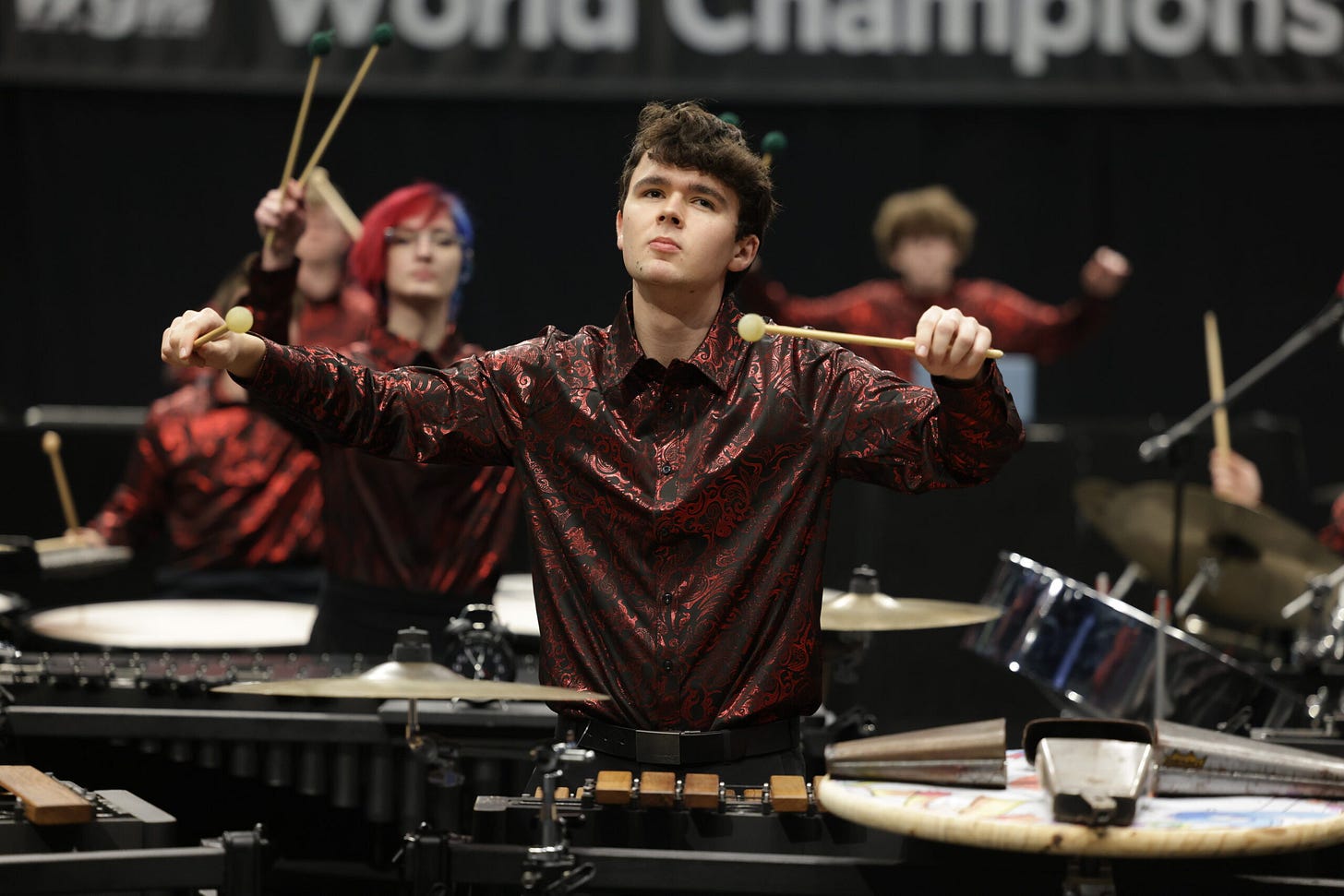Happy winter season! While some indoor circuits have been in swing for a few weeks, the 2023 Winter Guard International season is still young. Color guard just completed its second weekend of regionals, with eight shows in the books. Percussion and winds are next on deck, kicking off this weekend with 70 groups participating across four shows in Southern California, Chicago, Orlando, and Connecticut. After World Championships returned to being an in-person event for the first time in three years last year post-pandemic, WGI is looking to build upon that momentum with 430 percussion groups signed up for 23 different in-person events across the country over the next two months.
With a new winter season upon us and perhaps welcoming some marching arts fans who are less familiar with the percussion activity, we thought it could be helpful to explain how the ensembles are classified and judged, as well as similarities and differences with other marching arts activities. As you might expect, many of the same captions and performance elements are evaluated. However, the most significant difference to consider is smaller ensembles, shorter shows, and obviously, only percussive music (well….for the most part; more on that later).
I see these terms “World,” “Open,” and “A” floating around. What do they mean?
Let’s first talk about classification. Similar to the guard and winds activities, but unlike most fall marching band circuits, ensembles are grouped into classes by show complexity and ensemble talent. A Class is geared towards novice level ensembles, Open Class for intermediate level, and World Class for advanced level. Also, unlike competitive marching bands, many state/local circuits use the same classification and judging system as WGI, so it is (theoretically) more possible to compare groups between circuits within the same class.
For the most part, groups choose which class they will compete in before each season starts. However, they can be reclassified at any point in the season, either by their own circuit or WGI. Typically reclassification will occur if an ensemble is out-scoring the rest of their class by a large margin and judges believe they have the talent and a challenging enough show to be competitive in a higher class. And if a group is reclassified in WGI, they will typically be reclassified within their own circuit (and vice-versa).
Beyond classifying by ability, ensembles are also classified by type i.e. Scholastic or Independent. Scholastic ensembles are strictly school-affiliated groups, and WGI rules prohibit students from participating in another scholastic-level ensemble affiliated with a school outside their home district. However, Independent ensembles are not affiliated with any school (unless affiliated with a college or university), and most operate as standalone organizations. While not as common anymore, some DCI member corps operate independent-level ensembles such as Blue Knights and Spartans.
Combining all the factors mentioned above combines for six primary classifications: Independent World, Independent Open, Independent A, Scholastic World, Scholastic Open, and Scholastic A. Certain state/local circuits may offer more classes below the primary six, particularly for Scholastic ensembles, to accommodate groups of a broader range of skill and age range (i.e., middle school aged students).
Percussion is unique because it has two “subtypes” of activities. Most ensembles are considered marching units that include a battery drumline that performs their program with a visual element accompanied by a non-marching front ensemble. However, WGI percussion also offers a concert division for traditional concert percussion ensembles. WGI only allows Scholastic ensembles to participate in the concert division, and the division carries the same A, Open, and World classification as the marching division.

What are some other basic rules to know?
Beyond how classification works, there are other rules to be aware of for the percussion activity. For one, all members that participate in an independent-level ensemble must be younger than 22 years old by April 1st. However, even though DCI institutes a similar age limit for its participating corps and members, the WGI Percussion age limit has been hotly debated over the years, especially considering such a rule does not exist for color guard groups that compete in the Independent World class. Despite the ongoing debate, it has seemed to be the case many times that WGI does not intend on changing this rule anytime soon.
Another rule and nuance to keep in mind is that the time length of a percussion ensemble’s performance is much shorter than the average competitive marching band or drum corps show. Performance block lengths are assigned by class - 9 minutes for A classes, 10 minutes for Open classes, and 11 minutes for World Classes. Because of these time crunches and the amount of equipment and props that some ensembles utilize, half the science in operating a successful ensemble is having one that can efficiently get on and off the floor within their given timeframe. Likewise, WGI tends to be much more strict with timing to ensure a contest that stays on schedule; most penalties given that end up in recaps tend to be timing-related.
Regarding instrumentation, rules have become much more lenient over the course of the activity’s history. Beyond the standard marching percussion and front ensemble instrumentation, WGI has arguably been more innovative in their rules than other marching arts organizations; such a case is how they allowed mic’d and electronic instruments years before it was considered in DCI. More recently, wind instruments have been allowed, opening the door for new possibilities in show design. For example, RCC won the Independent World title in 2018 with a trumpet soloist featured throughout the performance, while Greenfield-Central HS made finals in Scholastic Open last year with a show that included 20 brass players accompanying the ensemble to play the finale from Pines of Rome at the end of their show.
How are the ensembles scored?
Now that we’ve discussed some of the major rules in the percussion activity, let’s tie that all into how ensembles are judged. Like competitive marching band and drum corps, percussion shows are judged for their effect (or show design) and musical and visual elements. Marching percussion scoring sheets are divided into four captions: Effect - Music; Effect - Visual; Music, and Visual. Without a marching element, concert percussion scoring sheets are only divided into two captions: Music and Artistry. At most competitions, there is one judge per caption; however, at bigger and more important events - mainly at WGI World Championships - two judges may be assigned per caption, otherwise known as a “double panel.”
When scoring marching percussion, Effect - Music and Music are each worth 30 points, while the remaining two visual captions are each worth 20 points. In cases where there are two judges per caption, each judge's scores are averaged to find a total caption score. Depending on how you want to combine the captions, the assigned point totals allow for effect elements to be worth half the score, and for the musical component to be more valuable than the visual component. As for the Concert division, the two captions are split into an even 50/50 split.
Breaking it down further, captions are split into two sub-captions to give two different pieces each judge is watching for. Effect captions are split into overall effect and music/visual effect, while the Music and Visual captions are divided into performance quality and composition. Sub-caption scores are scored out of 100, which may seem confusing initially, but it is done to normalize all scores on the same scale. A final caption score is determined by adding the two sub-caption scores, dividing by 200, and multiplying by the number of points the caption is worth; however, in the case of the Music caption, the math is done slightly differently as the composition sub-caption is worth only 10 points while the performance sub-caption is worth 20 points.
So what exactly are the judges looking for before deciding a number? During a competition, judges use scoring sheets to help guide their decisions. WGI makes these publicly available in the Rules & Policies section of its website. As you can see, each caption’s sheet is broken down into its respective sub-captions with terms and elements that help guide the judges. To sum it up as concisely as possible: the Music and Visual captions tend to judge their respective show elements (as well as the performance and compositional quality) as standalone products and are perhaps a bit more objective than the Effect captions. Meanwhile, the Effect captions judge the performances as a whole, how well elements are connected to create one cohesive product, and the effectiveness of different elements to create an entertaining performance. Yes, I know it sounds vague, but lucky for you, our friend
wrote a whole separate piece last summer that dives into General Effect even further - check that piece out below for additional reading.And with that, we arrive at the end of Drums in a Gym 101. Hopefully, after reading this, you feel marginally more knowledgeable about WGI Percussion than when you started - or, at the very least, intrigued enough to follow the WGI season this spring. While it’s sometimes given a smaller spotlight within the marching arts, indoor percussion is an incredibly entertaining activity to watch and follow and arguably has a greater influence on the marching arts as a whole than some may realize. So, if you can, get to a show sometime in the next two months and support these incredible performers!
Marching Arts by the Numbers is a current staff writer and stats guru for General Effect Media. He has been involved in the marching arts activity for nearly two decades in a variety of roles. Marching Arts by the Numbers is his latest project with the vision of being the primary source of statistical information for the marching arts community. You can follow more of his work at @band_scores on Twitter.





